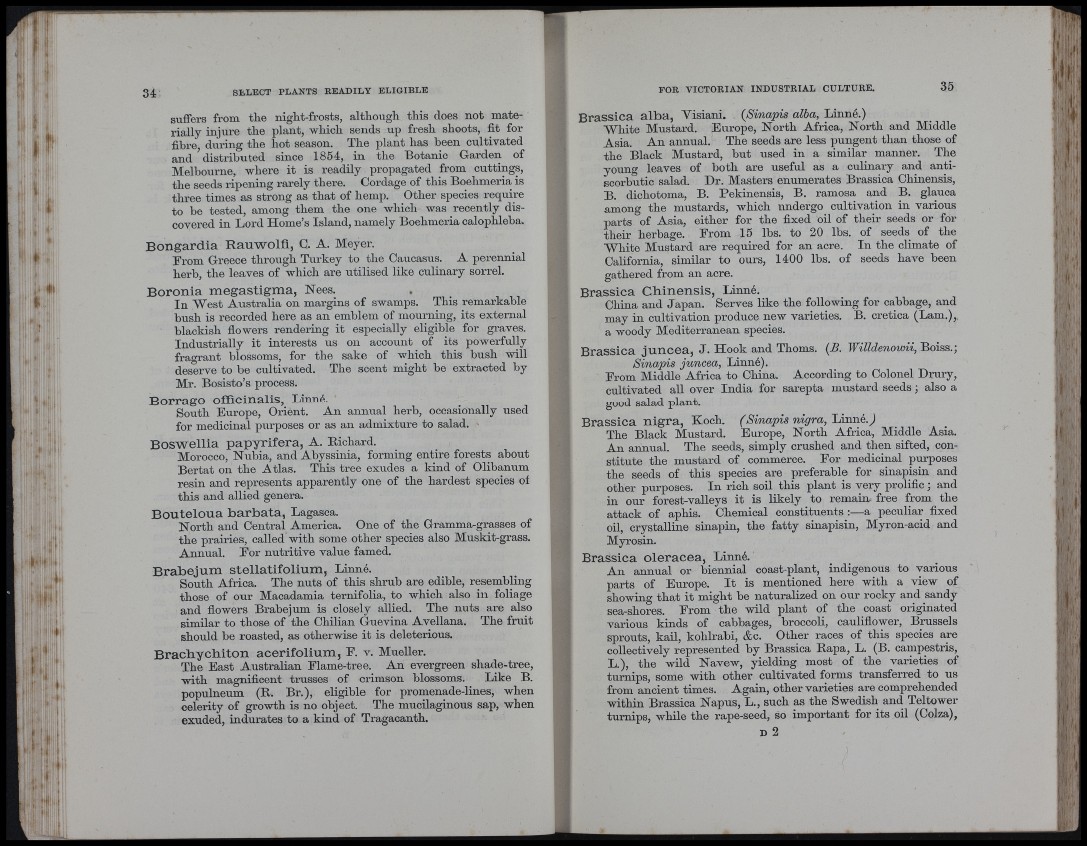
■h
:
suffers from the night-frosts, although this does not materially
injure the plant, which sends up fresh shoots, fit for
fibre, during tbe hot season. The plant has been cultivated
a n d ’ distributed since 1854, m tbe Botanic Garden of
Melbourne, where it is readily propagated from cuttings,
tbe seeds ripening rarely there. Cordage of this Boebmeria is
three times as strong as that of hemp. Other species require
to be tested, among them the one which was recently discovered
in Lord Home’s Island, namely Boehmeria calophleba.
Bongardia Rauwolü, C. A. Meyer.
From Greece through Turkey to the Caucasus. A perennial
herb, the leaves of which are utilised like culinary sorrel.
Boronia megastigma, Nees.
In West Australia on margins of swamps. This remarkable
bush is recorded here as an emblem of mourning, its external
blackish fiowers rendering it especially eligible for graves.
Industrially it interests us on account of its powerfully
fragrant blossoms, for the sake of which this bush will
deserve to be cultivated. The scent might be extracted by
Mr. Bosisto’s px'ocess.
Borrago officinalis, Linné.
South Europe, Orient. An annual herb, occasionally used
for medicinal purposes or as an admixture to salad.
Boswellia papyrifera, A. Richard.
Morocco, Nubia, and Abyssinia, forming entire forests about
Bertat on tbe Atlas. This tree exudes a kind of Olibannm
resin and represents apparently one of the hardest species of
this and allied genera.
Bouteloua barbata, Lagasca.
North and Central America. One of the Gramma-grasses of
the prairies, called with some other species also Muskit-grass.
Annual. For nutritive value famed.
Brabejum stellatifolium, Linné.
South Africa. The nuts of this shrub are edible, resembling
those of our Macadamia ternifolia, to which also in foliage
and flowers Brabejum is closely allied. The nuts are also
similar to those of the Chilian Gnevina Avellana. The fruit
should be roasted, as otherwise it is deleterious.
Bracbycbiton acerifolium, E. v. Mueller.
The East Australian Elame-tree. An evergreen shade-tree,
with magnificent trusses of crimson blossoms. Like B.
populneum (R. Br.), eligible for promenade-lines, when
celerity of growth is no object. The mucilaginous sap, when
exuded, indurates to a kind of Tragacanth.
Brassica alba, Visiani. {Sinapis alba, Linné.)
White Mustard. Europe, North Africa, North and Middle
Asia. An annual. The seeds are less pungent than those of
the Black Mustard, but used in a similar manner. The
young leaves of both are useful as a culinary and antiscorbutic
salad. Dr. Masters enumerates Brassica Chinensis,
B. dicbotoma, B. Pekinensis, B. ramosa and B. glauca
among the mustards, which undergo cultivation in various
parts of Asia, either for the fixed oil of their seeds or for
their herbage. From 15 lbs. to 20 lbs. of seeds of the
White Mustard are required for an acre. In the climate of
California, similar to ours, 1400 lbs. of seeds have been
gathered from an acre.
Brassica Cbinensis, Linné.
China and Japan. Serves like the following for cabbage, and
may in cultivation produce new varieties. B. crética (Lam.),
a woody Mediterranean species.
Brassica júncea, J. Hook and Thoms. {B. Willdenowii, Boiss.;
Sinapis júncea, Linné).
From Middle Africa to China. According to Colonel Drury,
cultivated all over India for sarepta mustard seeds ; also a
good salad plant.
Brassica nigra, Koch. ( Sinapis nigra, Linné, j
The Black Mustard. Europe, North Africa, Middle Asia.
An fl.nrmal. The sceds, simply crushed and then sifted, constitute
the mustard of commerce. Eor medicinal purposes
the seeds of this species are preferable for sinapisin and
other purposes. In rich soil this plant is very prolific ; and
in our forest-valleys it is likely to remain* free from the
attack of aphis. Chemical constituents:—a peculiar fixed
oil, crystalline sinapin, the fatty sinapisin, Myron-acid and
Myrosin.
Brassica olerácea, Linné.
An aTinna.I or biennial coast-plant, indigenous to various
parts of Europe. I t is mentioned here with a view of
showing th a t it might be naturalized on our rocky and sandy
sea-sbores. Erom tbe wild plant of tbe coast originated
various kinds of cabbages, broccoli, cauliflower, Brussels
sprouts, kail, kohlrabi, &c. Other races of this species are
collectively represented by Brassica Rapa, L. (B. campestris,
L.), the wild Navew, yielding most of the varieties of
turnips, some with other cultivated forms transferred to ns
from ancient times. Again, other varieties are comprehended
within Brassica Napus, L., such as the Swedish and Teltower
turnips, while the rape-seed, so important for its oil (Colza),
D 2
I .j; (